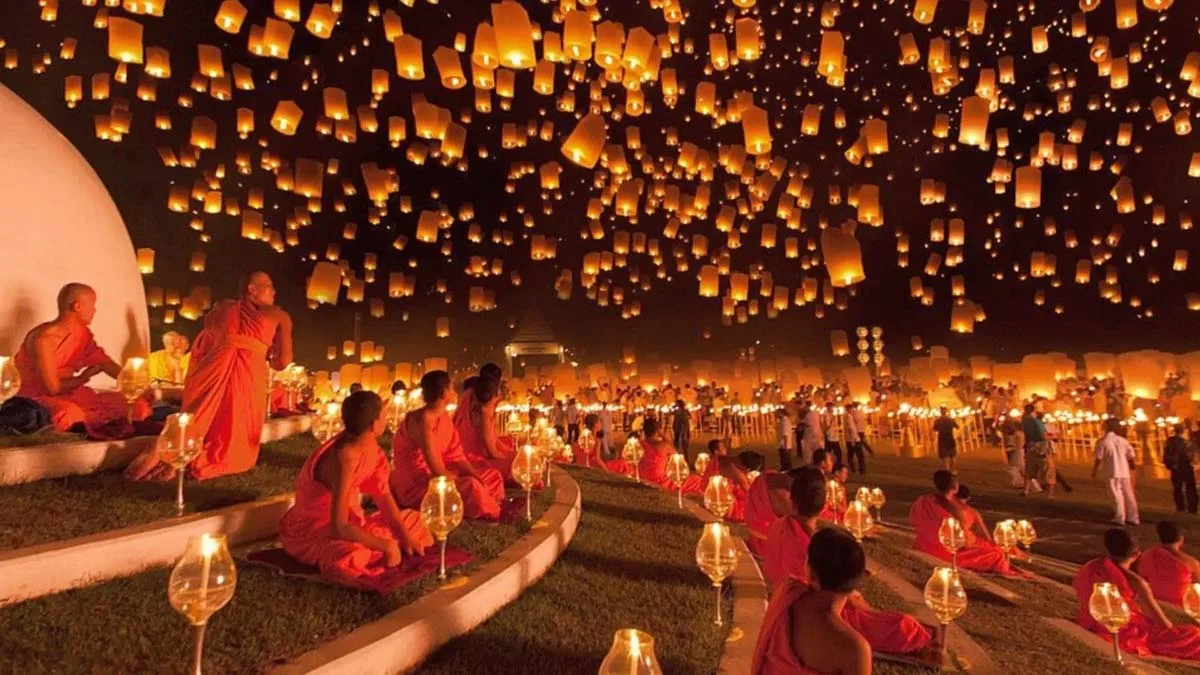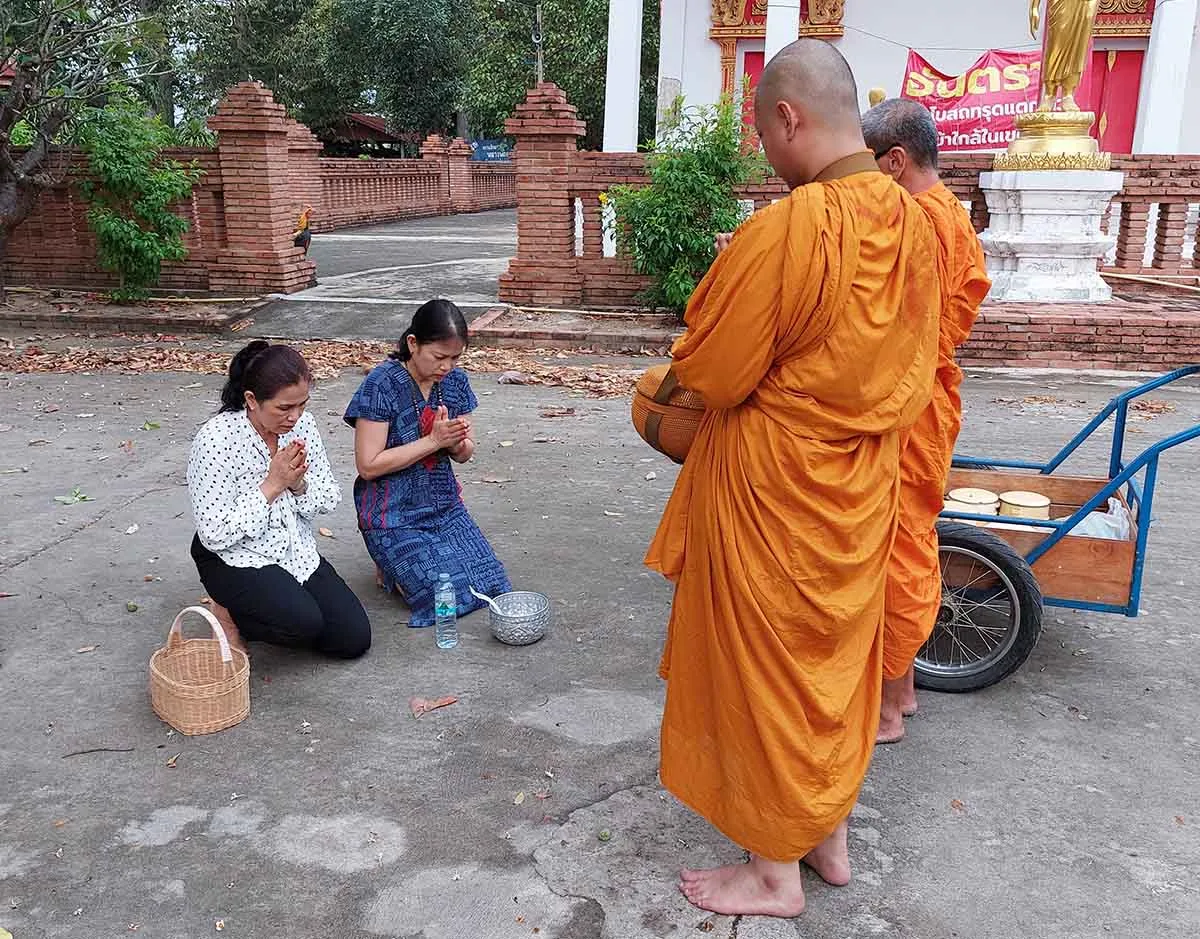Where Faith Meets Everyday Life
Walk through any Thai town at dawn, and you’ll see monks collecting alms, golden temple roofs gleaming, and people offering food with joined hands.
That quiet morning moment sums up a truth: Theravāda Buddhism isn’t just a religion in Thailand — it’s a way of life woven into every sunrise, smile, and festival.
According to recent statistics, approximately 94.5% of Thais practice Theravada Buddhism, making it the dominant faith. Islam follows with around 4.3%, primarily among the Malay-speaking communities in the southern provinces. Christianity accounts for roughly 1.1%, while other religions, including Hinduism, Sikhism, and traditional Chinese beliefs, make up the remaining fraction. Despite this religious diversity, Thailand is renowned for its religious tolerance, embracing harmony among different faiths.
Now, let’s dive into the heart of religion in Thailand—Theravada Buddhism.
A Brief History: From India to Siam
Theravāda Buddhism — the “Teaching of the Elders” — traces its roots to the Buddha’s earliest disciples. It reached what is now Thailand over 2,000 years ago, first spreading from Sri Lanka and later flourishing during the Sukhothai Kingdom (13th century).
Thai kings promoted the faith as the moral and cultural backbone of society. Monks educated the people, temples became schools, and Buddhist ethics shaped governance.
Today, over 90% of Thais identify as Buddhist, making Thailand the world’s heartland of Theravāda practice.
Learn more about Life of Theravāda Monks in Thailand

How Buddhism Shapes Thai Values
Theravāda Buddhism deeply influences Thai behavior, traditions, and mindset.
At the core are the Five Precepts — basic moral principles most Thais learn from childhood:
Avoid harming living beings
Avoid stealing
Avoid sexual misconduct
Avoid lying
Avoid intoxicants that cloud the mind
These precepts form the foundation of Thai politeness, respect, and calm demeanor. Even modern laws and social etiquette echo these principles.
Learn about Tak Bat: Sacred Buddhist Almsgiving Ceremony
Temples: The Heart of Every Community
Every Thai village has a wat — a Buddhist temple that serves as its spiritual, educational, and social center.
Wats host everything from festivals and funerals to meditation retreats and community events.
Historically, temples were schools where monks taught children to read and write. Even today, temples remain places of guidance, moral teaching, and refuge during difficult times.
Across Thailand, certain temples stand out not just for their architecture, but for their spiritual legacy. These wats are living symbols of Theravāda Buddhism’s enduring presence:
Wat Phra Kaew (Bangkok) – Known as the Temple of the Emerald Buddha, it’s Thailand’s most sacred site and a cornerstone of royal and religious tradition.
Wat Pho (Bangkok) – Home to the Reclining Buddha and traditional Thai massage, this temple blends spiritual reverence with cultural education.
Wat Arun (Bangkok) – The Temple of Dawn rises over the Chao Phraya River, symbolizing enlightenment and renewal.
Wat Mahathat (Ayutthaya) – Famous for the Buddha head entwined in tree roots, it’s a haunting reminder of impermanence and historical resilience.
Wat Chaiwatthanaram (Ayutthaya) – A majestic riverside temple reflecting Khmer influence and royal devotion.
Wat Rong Khun (Chiang Rai) – The White Temple is a modern masterpiece that fuses Buddhist symbolism with surreal art.
Wat Phra That Doi Suthep (Chiang Mai) – Perched on a mountain, this temple offers panoramic views and spiritual serenity.
Wat Tha Sung (Uthai Thani) – Known for its dazzling crystal hall, it’s a hidden gem of spiritual elegance.
Each of these temples reflects a unique facet of Thai Buddhism — from royal patronage to rural devotion, from ancient ruins to contemporary art. Explore them to understand how Theravāda Buddhism lives not just in philosophy, but in stone, ritual, and community.

Buddhist Festivals: Celebrating with Mindfulness
Buddhism colors the Thai calendar with festivals that blend devotion and joy:
Makha Bucha Day – honors the Buddha’s early disciples.
Visakha Bucha Day – celebrates the Buddha’s birth, enlightenment, and passing.
Asalha Puja – marks the first sermon of the Buddha.
Kathin Ceremony – when laypeople offer new robes to monks.
Every event combines community, merit-making, and joy, proving that spiritual life in Thailand is far from solemn — it’s vibrant and inclusive.
Find out the festival that best suits you at hThailand Festivals Calendar: Celebrate the Culture
Monks: Moral Guides and Role Models
In Thai culture, monks are not distant figures; they are spiritual mentors, community teachers, and moral anchors.
Many Thai men even spend a short time ordained as monks — often for a few weeks — to gain spiritual merit and discipline.
Monks lead prayers, perform blessings, and remind society of mindfulness, compassion, and impermanence.
Learn more about Life of Theravāda Monks in Thailand
Art, Architecture, and Everyday Culture
From temple murals to golden chedis, Buddhist symbolism fills Thai art and design.
Lotus motifs represent purity, and serene Buddha statues remind people to stay calm in chaos.
Even Thai language and greetings carry Buddhist influence — saying “Sawasdee” with palms together is a gesture of respect and humility rooted in Buddhist etiquette.
Funny Fact
In rural Thailand, monks sometimes bless new tractors, smartphones, or even Wi-Fi routers — because in a Buddhist society, mindfulness can live alongside technology. Enlightenment might be ancient, but it’s also upgrade-compatible!
Lesser-Known Fact
The Thai word for temple, Wat, comes from the Pali vāṭa, meaning “enclosure.” It symbolizes a protected space for spiritual growth, not just a building — explaining why every Wat feels like a peaceful world apart from daily life.
Buddhism in Everyday Thai Life

Theravada Buddhism isn’t just about temple visits – it’s deeply intertwined with Thai customs. Here’s where you’ll see it in action:
- Daily Offerings: Many Thais give food to monks in the morning as a way to earn merit.
- Buddhist Holidays: Big celebrations like Makha Bucha and Visakha Bucha mark significant events in the Buddha’s life.
- Spirit Houses: Even in Bangkok’s concrete jungle, small spirit houses stand outside businesses and homes, offering a place for protective spirits.
- Wai Greeting: The Thai “wai” (a palms-together bow) is inspired by Buddhist humility and respect.
Common Questions About Theravāda Buddhism in Thailand
It means “Teaching of the Elders” — the oldest surviving branch of Buddhism, focused on the Pali Canon and personal enlightenment through wisdom and meditation.
It was supported by Thai monarchs for centuries, integrated into education, law, and social order — becoming part of the nation’s identity.
Not all, but Buddhist values influence nearly everyone. Even non-practicing Thais participate in temple festivals or offer alms for good karma.
They teach moral conduct, offer blessings, and provide community leadership. Many temples also run schools and charity programs.
Almost every Thai holiday, sculpture, and temple design carries Buddhist symbolism — reminding people to balance joy with mindfulness.
Absolutely! Just remember to dress modestly (cover shoulders and knees) and remove your shoes before entering temple halls.
Yes, foreigners are welcome to visit temples in Thailand to study Buddhism. Many temples, especially in cities like Bangkok and Chiang Mai, offer meditation retreats, Dhamma talks, and even ordination programs for non-Thais. Some well-known temples, such as Wat Suan Mokkh and Wat Pah Nanachat, provide teachings in English and structured programs for those interested in learning about Buddhism and meditation.
Conclusion: A Living Heritage of Peace
Theravāda Buddhism gives Thailand its rhythm — guiding how people think, act, and celebrate life.
From golden temples to daily almsgiving, it’s a living tradition that turns philosophy into daily kindness.
In Thailand, Buddhism isn’t just about reaching Nirvana — it’s about making every day a little more peaceful.
